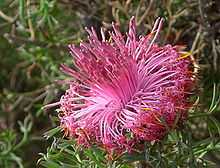Isopogon dubius
From Wikipedia, the free encyclopedia
| Isopogon dubius | |
|---|---|
 | |
| Isopogon dubius in the Dryandra Woodland | |
| Scientific classification | |
| Kingdom: | Plantae |
| (unranked): | Angiosperms |
| (unranked): | Eudicots |
| Order: | Proteales |
| Family: | Proteaceae |
| Genus: | Isopogon |
| Species: | I. dubius |
| Binomial name | |
| Isopogon dubius (R.Br.) Druce[1] | |
| Synonyms | |
|
Atylus roseus (Lindl.) Kuntze | |
Isopogon dubius (Pincushion Coneflower) is a small shrub that is endemic to the south-west of Western Australia. It is usually between 0.3 and 1.5 metres high and has divided leaves which are 40 to 50 mm in length [2]
The deep pink inflorescences are around 50 mm in diameter and appear from July to October in the species native range.[2][3]
Cultivation
Isopogon dubius was first cultivated in Europe in the 1800s. It prefers dry summers and excellent drainage and will tolerate moderate frosts.[2] Full sun is required for the best flower display, although the plant can be grown in partial shade.[2]
External links
- "Australian National Botanic Gardens - illustration of Isopogon dubius by Edgar Dell". Retrieved 2009-10-04.
References
| Wikimedia Commons has media related to Isopogon dubius. |
- ↑ "Isopogon dubius". Australian Plant Name Index (APNI), IBIS database. Centre for Plant Biodiversity Research, Australian Government.
- ↑ 2.0 2.1 2.2 2.3 "Isopogon dubius". Association of Societies for Growing Australian Plants (ASGAP). Retrieved 2008-08-10.
- ↑ "Isopogon formosus". FloraBase. Department of Environment and Conservation, Government of Western Australia.
This article is issued from Wikipedia. The text is available under the Creative Commons Attribution/Share Alike; additional terms may apply for the media files.